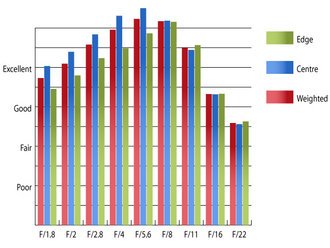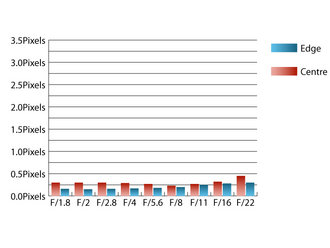Olympus 45mm f/1.8 Zuiko Digital Micro Four Thirds Lens Review
Olympus 45mm f/1.8 Zuiko Lens Performance
At maximum aperture, this lens already produces excellent resolution in the centre portion of the frame. Towards the edges, the resolution remains very good, which is excellent performance for a wide aperture lens. Stopping the lens down to between f/5.6 and f/8 results in outstanding sharpness across the frame with sharpness in the centre being at its highest at f/5.6. Resolution @ 45mm | How to read our chartsThe blue column represents readings from the centre of the picture frame at the various apertures and the green is from the edges. Averaging them out gives the red weighted column.The scale on the left side is an indication of actual image resolution. The taller the column, the better the lens performance. Simple. For this review, the lens was tested on an Olympus PEN Mini E-PM1 using Imatest. |
Chromatic aberrations are kept well below levels that may become noticeable, in either large prints or harsh crops from the edges of the frame. At their worst, CA levels reach 0.45 pixel widths at f/22.
As falloff and distortion are corrected by the camera's image processing engine when shooting JPEGs, falloff and distortion will only be easily visible when shooting in RAW format.
 Chromatic Aberration @ 45mm | How to read our chartsChromatic aberration is the lens' inability to focus on the sensor or film all colours of visible light at the same point. Severe chromatic aberration gives a noticeable fringing or a halo effect around sharp edges within the picture. It can be cured in software.Apochromatic lenses have special lens elements (aspheric, extra-low dispersion etc) to minimize the problem, hence they usually cost more. For this review, the lens was tested on an Olympus PEN Mini E-PM1 using Imatest. |
Falloff of illumination towards the corners is very well controlled, especially so for a fast aperture lens. At f/1.8 the corners are only 0.76 stops darker than the image centre and visually uniform illumination is achieved at f/2.8.
Levels of distortion are also very low, as you might expect for a prime lens like this. Imatest managed to detect 0.215% barrel distortion, which will be very difficult to spot by eye, even with straight lines close to the edges of the frame.
Flare is rarely an issue with this lens, except in exceptional circumstances. Shooting directly into bright sources of light will result in a loss of contrast, but no more so than similar lenses. An optional lens hood can be acquired and although this optic isn't overly prone to flare, it would've been nice for the hood to come included.
Add your message
Login required
Please login here or if you've not registered, you can register here. Registering is safe, quick and free.
Please login here or if you've not registered, you can register here. Registering is safe, quick and free.
photodo Stats
1102 lenses
428 MTF tests
74 in-depth photodo reviews
100+ users join each day
Help the lens community by reviewing or rating a lens today via our lens search
428 MTF tests
74 in-depth photodo reviews
100+ users join each day
Help the lens community by reviewing or rating a lens today via our lens search
Latest Lens Reviews
- Chinon 28mm f/2.8 Vintage Lens Review
- Canon EF 70-200mm f/4L IS II USM Lens Review
- Samyang AF 85mm f/1.4 EF Review
- Sigma 70mm f/2.8 DG Macro Art Review
- Samyang AF 24mm f/2.8 FE Review
- Meike 50mm f/1.7 Review
- Tamron 70-210mm f/4 Di VC USD Review
- Lensbaby Burnside 35mm f/2.8 Review
- Asahi Super Takumar 50mm f/1.4 Review
- Asahi Super-Multi-Coated Takumar 135mm f/3.5 Review
